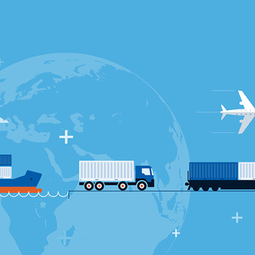
Published on 07/26/2016 | Operations
Whether by air, ground or sea, transportation and logistics are essential components to many enterprises’ productivity, and access to real-time data is critical. IoT can do much more than that, by allowing firms to cut costs, increase efficiency, and create new revenue streams.
Many businesses have already discovered the advantages of using mobile technologies, however, the unpredictable nature of fuel costs, rising labor rates, increased traffic and a changing regulatory environment, continue to make operations challenging.
#1 - End-to-End Visibility
Leveraging IoT technologies in order to achieve end-to-end visibility can result in a higher asset intelligence, leading to more informed decisions.
#2 - Warehouse Management
By reducing human intervention and enabling more machine-to-machine information sharing, enterprises can greatly increase efficiency and accuracy.
#3 - Fleet Management
By leveraging connected, mobile devices, enterprises can capture, share and manage data around their moving assets across the enterprise. Connectivity also enables enterprises to communicate with their technicians (drivers) anytime, anywhere, allowing them to be proactive with in-field repairs, maintenance, etc. With real-time updates on certain conditions such as bad weather or traffic, fleet technicians can better respond and/or prepare.
#4 -
#5 -
To reach a high level of performance, logistics companies need to make end-to-end improvements. Complete visibility facilitates more effective, timely decisions and reduces delays through quicker detection of issues.
Using RFID can reach nearly 100 percent shipping and receiving accuracy, 99.5 percent inventory accuracy, 30 percent faster order processing and 30 percent reduction in labor costs.
Mobile technologies provide businesses line of sight into equipment, inventory and business processes. This asset intelligence allows your organization to increase their efficiency by providing them real-time data across their entire supply chain.

The warehouse and/or yard are at the core of transportation and logistics businesses. Their efficiency directly impacts the cost of doing business and the ability to compete. By converting the physical to digital, transportation and logistics warehouses can capture and share their mission-critical data across the cloud, ensuring they have the right products in the right place at the right time. Yard personnel are frequently moving around on foot or in vehicles, manually conducting their routine tasks.
This process is time intensive and prone to error which causes a number of visibility-related problems including redundant trailer moves, yard gate congestion, product shrinkage, wasted fuel and lost time. To address these issues, organizations across the supply chain implement RFID systems that automate asset tracking and location.
The warehouse and/or yard are at the core of transportation and logistics businesses. Their efficiency directly impacts the cost of doing business and the ability to compete. By converting the physical to digital, transportation and logistics warehouses can capture and share their mission-critical data across the cloud, ensuring they have the right products in the right place at the right time. Yard personnel are frequently moving around on foot or in vehicles, manually conducting their routine tasks.
This process is time intensive and prone to error which causes a number of visibility-related problems including redundant trailer moves, yard gate congestion, product shrinkage, wasted fuel and lost time. To address these issues, organizations across the supply chain implement RFID systems that automate asset tracking and location.
When it comes to transportation and logistics, fleet management plays a critical role in managing maintenance schedules, everyday vehicle usage and service routes. In order to maximize productivity and operational efficiency, fleet downtime must be minimized. With mobile scanners, computers and RFID systems alone, enterprises can gain visibility into their assets and better streamline operations to keep their fleet moving.
For field technicians, real-time visibility into driver and vehicle performance is critical. This visibility can be used to increase the safety of technicians, reduce damaged inventory and decrease insurance-related costs all of which are critical to an enterprise’s bottom line.
When it comes to transportation and logistics, fleet management plays a critical role in managing maintenance schedules, everyday vehicle usage and service routes. In order to maximize productivity and operational efficiency, fleet downtime must be minimized. With mobile scanners, computers and RFID systems alone, enterprises can gain visibility into their assets and better streamline operations to keep their fleet moving.
For field technicians, real-time visibility into driver and vehicle performance is critical. This visibility can be used to increase the safety of technicians, reduce damaged inventory and decrease insurance-related costs all of which are critical to an enterprise’s bottom line.